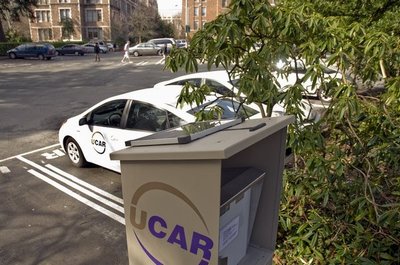March 5, 2009
Fleet Services goes green: New plug-in hybrid car, solar-assisted key manager
Fleet Services (formerly Motor Pool) has added some new features to its UCAR program, making car-sharing more convenient — and green — than ever for the UW community.
Four UCARs are now available in the N22 parking lot, directly across from Hall Health. The site features a solar-assisted key manager, the electronic box where UCAR users retrieve vehicle keys after making reservations online. A solar panel on top of the key manager collects energy to supplement its battery, helping to extend the battery life, according to Fleet Services Program Coordinator Larissa Austin.
“We’re still doing some testing, but what we’re projecting is that rather than switching out the battery every three weeks, we’d need to switch out the battery every month and half,” Austin said.
And the solar panel will help power the key manager under Seattle’s notoriously cloudy skies; Austin said it even drew some energy from fluorescent lights during preliminary tests.
If the solar-assisted key manager proves to be efficient, Fleet Services may continue to use it if it develops other outdoor UCAR sites. Currently, other UCAR locations are in the Center Plaza Garage, the South Campus Parking Garage, the E2 parking lot, the UW Tower A Garage and UW Bothell’s South Parking Garage. Fleet Services offers 48 vehicles at the Seattle campus, from hybrid cars to eight-passenger vans, and three hybrid vehicles at UW Bothell. It is a Transportation Services program, which is part of Facilities Services.
Anyone with a valid NetID and driver’s license can rent a UCAR, drive it for University purposes only, then return it to its original location and drop off the key. The UCAR system keeps automatic track of vehicle usage and charges departmental budgets at the end of each month. Click here for more information about UCAR.
Fleet Services is also experimenting with energy conservation in another way: by introducing its first plug-in hybrid car, a Toyota Prius. The car’s home base is the S1 lot in the South Campus Parking Garage, and it has been assigned to the nearby Department of Laboratory Medicine to use for a courier route. The department uses four other Fleet Services hybrids for its routes; they traded one regular Prius for the plug-in version last week.
Laboratory Medicine Program Supervisor Tucker Sparkman oversees use of the plug-in hybrid. He assigned it to a route within the metropolitan Seattle area, where it travels between UW Medical Center, Harborview Medical Center, Seattle Cancer Care Alliance, Seattle Children’s Hospital and more to pick up lab specimens and drop off lab reports and supplies.
“We decided it was the route that would be most appropriate for the electric plug-in car because you get something like 40 miles of travel before you’ve expended the charge in the auxiliary battery,” Sparkman said. Once the auxiliary battery power is depleted, the vehicle then reverts to operating as a normal Prius, using both gas and electric power.
Sparkman says his goal is to maximize all-electric use of the plug-in hybrid, meaning drivers need to keep in mind the car’s limitations. “To maximize the use of the battery, you need to drive in a fairly gentle fashion,” he said. “If you do a lot of heavy acceleration from stoplights and things like that, the car’s computer will utilize gas power to accelerate. When you drive over 35 mph, or turn on the heater, the car will take itself out of full-electric mode.”
Fleet Services has two other plug-in hybrids, but has not assigned them to departments yet. “We are currently working to place the hybrids with departments that would best utilize the plug-in technology,” Austin said.
One of the challenges is finding a place for each car to charge. Electricians had recently installed three standard 110-volt sockets in S1, and later added a 220-volt charging station to better accommodate the car. The plug-in hybrid takes five and a half to six hours to fully charge when plugged into a 110-volt socket; with the 220-volt charging station, it only takes about two hours, according to Austin.
“It’s a commendable project,” Sparkman said. “It’s good for the Earth and ecology, so we feel it’s worthwhile to pursue this technology.”


